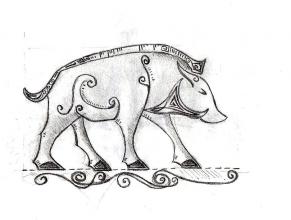You are here
Early settlers
Colonisation by us humans began around 14,000 years ago, once things had warmed up enough after the Ice Age and the tundra had thawed out sufficiently to allow tree cover to return.
If there were hominins living in Britain before the latest Ice Age, they spent the winter in south western Europe, just like some of their wealthier modern counterparts do today. But their “winter” was to last several thousand years. These Iberian shelterers have been identified as Celts. As soon as the climate improved, some of them took to their ships and colonised the west of Britain. Genetic markers show that these early settlers have had a big influence on the current population. Meanwhile the Gaels (possibly originating in Asia) moved through central into western Europe, bringing other “celtic” languages and cultures with them.
7500 years ago, immigrants were still walking into the region across what was to become the bed of the southern North Sea (Doggerland) and the English Channel. The sea levels were to rise a further 3 metres over a few hundred years soon afterwards, inundating mesolithic settlements off the coast of southern England and the Isle of Man. This was caused by a relatively small pulse of ice melt-water. In the previous 7000 years there had been two step changes in sea-level, each with a magnitude of the order of 20m, as the planet re-adjusted from the weight of massive ice sheets, and the resulting flow of meltwater into the seas. Following this third sea-level rise, we were collection of islands, and the sea was to figure more strongly in our cultures.
The western Celts probably arrived by sea and colonised Hibernia, the isle of Man and western Scotland. As anyone who has read Sellers and Yeatman will know, the “Scots” originated from Ireland. (It is likely that these folk never called themselves “Scots”, but were named by the Romans as “outsiders” or “raiders”). Meanwhile, the Gaels came in from central Europe and ended up in Wales, Cumbria and, possibly, Galloway. They spoke a form of gaelic that is now called brythonic, as distinct from the goldelic languages of their western cousins. The Romans wrote about them living in the Borders and Lothians.
Meanwhile, the Picts had settled in the north and east of Scotland. Even in the dark ages after the Roman invasion 2000 years ago, the Picts produced beautiful stone inscriptions depicting people and landscape, There is not much that remains of their culture apart from these richly decorated, but indecipherable, carvings. Even their original name is a mystery, they were named “Pictii” (the painted ones) by the Romans. Their language is lost, but was probably brythonic and related to the Welsh and the tribes in the east of England such as Boudicca's Iceni. By the time of Bede 1300 years ago, pictish was identified as a language distinct from gaelic and welsh, leading to the intriguing possibility that it was influenced by contacts with invaders from across the North Sea. In the end, the Picts were to lose their identity through these invasions, and were subsumed into the wider population around 1000 years ago.
"The Scots (originally Irish, but by now Scotch) were at this time inhabiting Ireland, having driven the Irish (Picts) out of Scotland; while the Picts (originally Scots) were now Irish (living in brackets) and vice versa. It is essential to keep these distinctions clearly in mind and verse visa."
W C Seller and R J Yeatman
1066 and All That: A Memorable History of England, comprising all the parts you can remember, including 103 Good Things, 5 Bad Kings and 2 Genuine Dates
